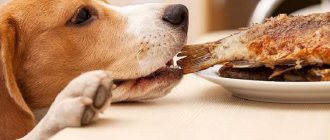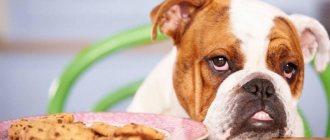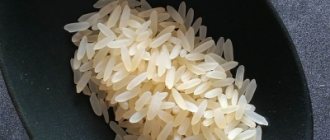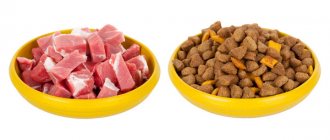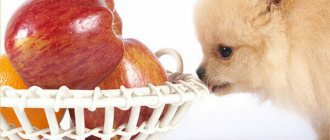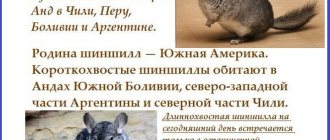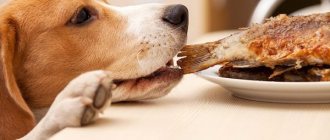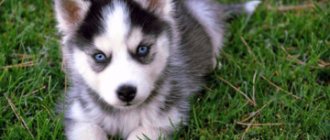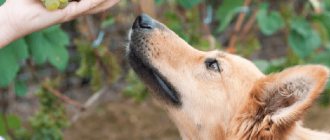Many owners consider their four-legged pet a member of the family. It is good when a dog enjoys the love of the household and takes part in family entertainment and trips. But her table should be separate. The diet of animals and humans has significant differences. The desire to pamper your beloved dog is understandable. But you need to choose treats carefully; they can cause significant harm to the dog’s health. What foods should not be in a dog's diet?
Dangerous sweets
Most children and adults' favorite treats are all kinds of sweets and confectionery. Even your four-legged pet will not refuse these treats. Many dogs enjoy eating pastries, sweets and cakes, and do not refuse sweet soda. These products are dangerous for animals and can cause a lot of harm.
Just like in humans, eating sweets disrupts the acid-base balance in dogs. But for animals this violation is more dangerous. A person can rinse his mouth, brush his teeth, restore balance. The dog does not have such an opportunity. Eating sweet foods leads to increased proliferation of carious bacteria and damage to teeth.
The dog’s body is not designed for such food, it is poorly digested, glucose levels increase, and metabolic processes are disrupted. Regular consumption of desserts will certainly lead to an increase in fat mass, disruptions in the functioning of the gastrointestinal tract, and diabetes.
One of the main enemies of dogs is chocolate. It contains large amounts of theobromine. This substance causes seizures in dogs and disrupts heart rhythm. Intoxication and even death cannot be ruled out.
Which of the “forbidden fruits” can sometimes be given to dogs?
It’s not always possible for owners to withstand the dog’s pitiful gaze and not pamper him with something tasty. The good news is that you can give up. In small quantities, the dog is allowed to eat:
- Pork. It is oily and may contain the plague virus and parasite eggs. But it can be given occasionally after careful heat treatment.
- Bread and flour products. Lead to excess weight, constipation, flatulence. You can pamper your pet occasionally. It is advisable to treat your dog not with buns and cookies, but with crackers and bagels.
- Celery. Contains many useful elements and vitamins. But the vegetable is coarse and fibrous, and dogs do not know how to chew - they only chop up the food and swallow it in pieces. If you want to give your dog celery, you need to grind it in a meat grinder or blender - this way the greens will easily pass through the digestive tract and be absorbed by the body.
- Cheese. Dogs love him. But the product contains lactose and fats, which are poorly digestible. Therefore, you can give low-fat varieties in small portions - as a treat or reward.
- Boiled and stewed cabbage. Heat-treated vegetables are better absorbed than raw vegetables. But the dog should be fed it carefully and occasionally.
- Peanuts and peanut butter. The only legume that is recommended for dogs in moderation. The kernels contain niacin, vegetable fats, vitamins E and group B.
- Dried fruits. Dried apricots and prunes are an excellent treat during training.
- Ice cream. Yes, harmful sweetness. But you can treat your dog once every 1-2 months. You need to take a clean filling without fillers or dyes. It is advisable to melt the dessert so that your pet does not catch a cold.
Prohibited drinks
Many dog owners have noticed that their pets enjoy tasting alcohol on occasion. They are especially fond of wine drinks and beer. Don't turn treating your dog to alcohol into fun. This is very dangerous for the dog. Intoxication with a fatal outcome in an animal can occur suddenly. In addition, periodic consumption of alcohol will provoke heart failure and paralysis of the nervous system.
There is no need to treat your pet to your favorite tea or coffee. Caffeine and tannin contained in drinks do not pose a danger to humans. But for a dog they can cause dysfunction of the gastrointestinal tract and heart disease.
It's just like people
Chocolate - theobromine contained in it causes bloating, vomiting, diarrhea, arrhythmia, convulsions, and in large quantities can be fatal.
Dogs love chocolate very much and, if the owner is irresponsible, can find and eat the treat on their own. And to remove this toxin from the body, you will need a lot of money and time spent on repeated trips to the veterinarian.
- Alcohol leads to nervous convulsions, heart failure and death.
- Baking with yeast leads to fermentation in the intestines, resulting in abundant gas formation, which, in addition to an unpleasant odor, causes pain in the animal.
If a dog eats raw dough, it can cause intestinal volvulus, which can be fatal.
Tea and coffee - the caffeine they contain leads to rapid heartbeat, aggressive behavior, and increased blood pressure.
Unacceptable Products
Patients of gastroenterologists, cardiologists, and nutritionists know very well which foods need to be excluded from the diet so that the cardiovascular and digestive systems work without increased stress and there are no disruptions in metabolic processes. All these prohibitions apply to dog diets as well. The menu of a four-legged pet should not contain the following products:
- pickled,
- spicy,
- salty,
- fatty,
- smoked.
A caring owner will never feed his dog sausages, sausages, or various fast foods. The animal's diet should not contain dishes with herbs or spices.
Consumption of such products will lead to disruption of the water-salt balance in the dog. The functioning of the liver and pancreas will be disrupted, which will have to function in an enhanced mode. Animals that regularly eat such food suffer from high blood pressure and joint pain.
General rules for healthy eating
Having any pet is a big responsibility. Every owner always strives to give their dog the best. Good nutrition will be the key to keeping her energetic and healthy.
The following recommendations should be followed:
- Organization of feeding. Food should be appropriate for the age and size of the dog. A small breed puppy or dog needs less food. Young dogs need a higher protein intake than older dogs.
- Prevention of disease development. A large dog needs a type of feeding that prevents rapid growth to prevent the development of dysplasia. Therefore, it is advisable that they take special dog food with certain characteristics and in appropriate proportions.
- Recording daily physical activity. A dog that walks several kilometers a day, runs, or is very active needs extra energy to stay strong and healthy.
- Obesity prevention. A dog that eats more food daily than it should for its weight, size and daily physical activity is almost certainly a candidate for overweight or obesity.
- The choice of dog food is medium to high quality. Good quality feeds are more expensive, but they guarantee good digestibility. With high-quality foods, the dog's body gets the maximum benefit from all nutritional contributions. High-quality food does not cause plaque to appear on the teeth, and the occurrence of gingivitis or inflammation of the gums is excluded.
- Removing junk food from reach. Overeating leads to problems with the gastrointestinal tract and is fraught with the development of obesity.
Do not use food rewards as a supplement to your daily ration. A product with a low calorie content is suitable for this, so that the pet does not suffer from overweight and obesity. Do not neglect this rule so as not to disrupt the health and quality of training.
Any dietary decision should be discussed with your veterinarian. Consultation is essential for the owner of a sick dog or a dog with special nutritional needs. The doctor will indicate the correct ingredients and portions of food for each pet, based on weight, breed and lifestyle.
Your dog should always have access to clean drinking water. Water is vital for the health of the animal, especially during the hot season. New dishes should be introduced into your pet’s diet gradually. When introducing new food without restrictions on the quantity, the dog may experience vomiting and diarrhea.
Harmful products of animal origin
Dogs are carnivores, but this does not mean that all animal products are acceptable to them. And in this category there are dangerous products that can cause harm.
The favorite pastime of all pets, regardless of breed, is gnawing on bones. They simultaneously enjoy a delicious product, train their mouth muscles, and sharpen their teeth. But the entertainment is dangerous if it is the long bones of a bird. They are easily chewed, resulting in sharp fragments. Contact with the gastrointestinal tract can cause organ damage. If a shrapnel gets stuck in the throat, the dog may choke.
You cannot feed your animal raw river fish. It contains many small bones that can injure the mucous membranes of the mouth, throat, and esophagus. In addition, raw fish contains many parasites that can infect your dog.
There are also dangerous products in the category of sea fish. A lot of histidine, which is poisonous to dogs, contains:
- tuna,
- mackerel,
- salmon,
- saury,
- sprats,
- herring.
There is no need to include blue whiting, capelin, hake, or cod in the menu. They contain trimethylamine oxide, which causes anemia.
Dangerous foods include raw eggs. Often these products are carriers of salmonella. The egg contains avidin. This enzyme inhibits synthesis processes and blocks the absorption of vitamin B1. Its deficiency causes deterioration in the condition of hair and skin.
Milk is a source of calcium and vitamins. It is an excellent addition to the diet for puppies. But the body of an adult dog is not adapted to assimilate this product. Drinking milk often leads to diarrhea.
Can dogs eat raw food? Myth or reality?
A number of European researchers in the field of cynology (Sweden) have spoken in recent years about the dangers of many raw foods. Almost all natural feeding. Especially raw meat products. Moreover, this is increasingly spreading both in Europe and beyond. This is motivated by the results of a number of studies. Samples taken from frozen meat from 10 different European producers were examined. Thus, in the studied samples of raw meat, bacteria were found, possibly pathogenic and with a high content of them. Enterobacteriaceae were found in all samples above the permissible threshold. Some samples contained salmonella or Campilobacter bacteria.
From this the following conclusions were drawn:
- In families with children and teenagers, dogs should be switched exclusively to dry food. Since children are susceptible to infection due to fragile immunity.
- Meat for feeding dogs must be thoroughly washed and then frozen before use. Defrosting should occur at a temperature no higher than 10°C. To process this product, use separate dishes and knives, which must then be thoroughly washed. Using detergents.
- Dogs should not be fed this food if they are receiving antibiotic therapy. It seems like this could lead to the emergence of antibiotic-resistant strains.
It should be noted that in the last couple of decades in Europe, very, very, to put it mildly, ridiculous newfangled trends are sometimes born. In cynology and veterinary medicine as well. Sometimes to the point of real absurdity. Therefore, all their fabrications should be taken with great caution.
Regarding this issue. The first conclusion frankly smacks of an attempt to advertise dry food as opposed to natural food. After all, the proportion of dog owners with children in families is very large. The second is quite fair, you cannot give meat to dogs without proper processing, although everyone has known this for a long time. But why are ordinary normal hygienic measures a revelation for Europeans? In principle, this is also not news - historically, the reputation of Europe for centuries not knowing what cleanliness is is the subject of jokes. Especially considering their super savings in water consumption. Well, the third conclusion - well, this is generally just bullshit, there’s no other way to put it.
Dangerous plant products
Not all dogs eat berries and fruits. But there are also fans of such products. Please note that persimmon, peach, and plum are unacceptable for animals. Their consumption will lead to intestinal obstruction. Some individuals may experience kidney failure due to raisins, grapes, and currants. There is no need to treat your dog to citrus fruits, pineapples, or kiwis. They can cause severe allergic reactions, and inflammation of the stomach is possible. You should not give your dog fruits with seeds. They contain cyanide, which is a poison. Even small doses can be very dangerous for a pet.
The most dangerous plant product for an animal is avocado. It contains persin, which causes severe intoxication in dogs. Broccoli is also a toxic product for pets. If this cabbage is consumed in large quantities, isocyanate accumulates, causing poisoning.
Potatoes are also not suitable for a dog's diet. The high content of starch, carbohydrates, and solanine make it harmful to the animal’s body. Boiled, raw, fried root vegetables are practically not digested in the gastrointestinal tract and overload the liver, pancreas, and intestines.
Why you shouldn't feed your dog chocolate.
The main component of chocolate is cocoa beans. They contain theobromine, which is similar in structure to caffeine. In dogs, these compounds overexcite the nervous system, shortening sleep time. Unlike humans, these substances are not broken down, but circulate in the blood for a long time, causing long-term adverse effects.
Signs of intoxication appear 6-12 hours after eating chocolate. Initially, excitement and hyperactivity appear. Then - hyperthermia, diarrhea and vomiting. Then you can observe the appearance of muscle cramps and spasms, shortness of breath, arterial hypotension, and tachycardia. In more severe cases, poisoning can result in coma and death.
The degree of poisoning depends on the amount of theobromine. There is more of it in dark chocolate than in milk chocolate. Up to 400 mg per 30 g of bitter and up to 60 mg per 30 g of dairy. The lethal dose for a dog is approximately 300 mg per kg of body weight. Therefore, for a 10-kilogram pet, consuming 100 grams of chocolate could well lead to death. Of course, for a dog weighing more than 30 kg, the lethal dose of chocolate is higher - about 650 g of dark bitter chocolate. Sweet bars made from “junk chocolate” are less dangerous because they contain much less cocoa beans.
If eating a dangerous product does occur, it is necessary to take urgent measures. Less than an hour after taking it means it makes sense to try to induce vomiting. Then you need to urgently contact a veterinary clinic. It should also be remembered that chocolate is digested and absorbed slowly. Substances that cause intoxication are also slowly removed from the body.
